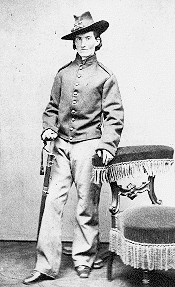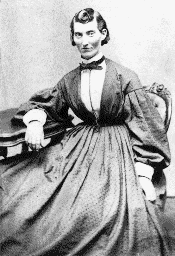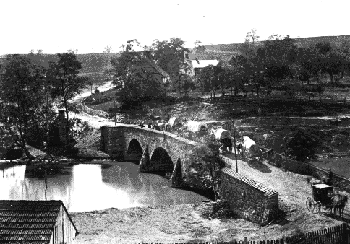|
Women Civil War Soldiers
Women Soldiers of the American Civil War
Women Soldiers of the Civil War, Part I
By DeAnne Blanton
© 1993 by
DeAnne Blanton
| Frances Clayton the Soldier |

|
| Boston Public Library |
Frances Clayton (right), in military uniform, served many months in Missouri
artillery and cavalry units.
It is an accepted convention that the Civil War was a man's fight. Images
of women during that conflict center on self-sacrificing nurses, romantic spies, or brave ladies maintaining the home front
in the absence of their men. The men, of course, marched off to war, lived in germ-ridden camps, engaged in heinous battle,
languished in appalling prison camps, and died horribly, yet heroically. This conventional picture of gender roles during
the Civil War does not tell the entire story. Men were not the only ones to fight that war. Women bore arms and charged into
battle, too. Like the men, there were women who lived in camp, suffered in prisons, and died for their respective causes.
Both the Union and Confederate armies forbade the enlistment of women. Women
soldiers of the Civil War therefore assumed masculine names, disguised themselves as men, and hid the fact they were female.
Because they passed as men, it is impossible to know with any certainty how many women soldiers served in the Civil War. Estimates
place as many as 250 women in the ranks of the Confederate army.(1) Writing in 1888, Mary Livermore of the U.S. Sanitary Commission
remembered that:
Some one has stated the number of women soldiers known to the service
as little less than four hundred. I cannot vouch for the correctness of this estimate, but I am convinced that a larger number
of women disguised themselves and enlisted in the service, for one cause or other, than was dreamed of. Entrenched in secrecy,
and regarded as men, they were sometimes revealed as women, by accident or casualty. Some startling histories of these military
women were current in the gossip of army life.(2)
Livermore and the soldiers in the Union army were not the only ones who knew
of soldier-women. Ordinary citizens heard of them, too. Mary Owens, discovered to be a woman after she was wounded in the
arm, returned to her Pennsylvania home to a warm reception and press coverage. She had served for eighteen months under the
alias John Evans.(3)
| Frances Clayton |

|
| Boston Public Library |
In the post - Civil War era, the topic of women soldiers continued to arise
in both literature and the press. Frank Moore's Women of the War, published in 1866, devoted an entire chapter to
the military heroines of the North. A year later, L. P. Brockett and Mary Vaughan mentioned ladies "who from whatever cause
. . . donned the male attire and concealed their sex . . . [who] did not seek to be known as women, but preferred to pass
for men."(4) Loreta Velazquez published her memoirs in 1876. She served the Confederacy as Lt. Harry Buford, a self-financed
soldier not officially attached to any regiment. Frances Clayton (left) served many months in Missouri artillery
and cavalry units.
The existence of soldier-women was no secret during or after the Civil War.
The reading public, at least, was well aware that these women rejected Victorian social constraints confining them to the
domestic sphere. Their motives were open to speculation, perhaps, but not their actions, as numerous newspaper stories and
obituaries of women soldiers testified.
Most of the articles provided few specific details about the individual woman's
army career. For example, the obituary of Satronia Smith Hunt merely stated she enlisted in an Iowa regiment with her first
husband. He died of battle wounds, but she apparently emerged from the war unscathed.(5) An 1896 story about Mary Stevens
Jenkins, who died in 1881, tells an equally brief tale. She enlisted in a Pennsylvania regiment when still a schoolgirl, remained
in the army two years, received several wounds, and was discharged without anyone ever realizing she was female.(6) The press
seemed unconcerned about the women's actual military exploits. Rather, the fascination lay in the simple fact that they had
been in the army.
| Burnside Bridge, Antietam, Maryland |

|
| NARA |
In 1862, at least four women, including Sarah Edmonds Seelye, converged on
Antietam, Maryland. With more than 20,000 casualties, September 17 was the bloodiest single-day of the Civil War.
The army, however, held no regard for women soldiers, Union or Confederate.
Indeed, despite recorded evidence to the contrary, the U.S. Army tried to deny that women played a military role, however
small, in the Civil War. On October 21, 1909, Ida Tarbell of The American Magazine wrote to Gen. F. C. Ainsworth,
the adjutant general: "I am anxious to know whether your department has any record of the number of women who enlisted and
served in the Civil War, or has it any record of any women who were in the service?" She received swift reply from the Records
and Pension Office, a division of the Adjutant General's Office (AGO), under Ainsworth's signature. The response read in part:
I have the honor to inform you that no official record has been found
in the War Department showing specifically that any woman was ever enlisted in the military service of the United States as
a member of any organization of the Regular or Volunteer Army at any time during the period of the civil war. It is possible,
however, that there may have been a few instances of women having served as soldiers for a short time without their sex having
been detected, but no record of such cases is known to exist in the official files.(7)
This response to Ms. Tarbell's request is untrue. One of the duties of the
AGO was maintenance of the U.S. Army's archives, and the AGO took good care of the extant records created during that conflict.
By 1909 the AGO had also created compiled military service records (CMSR) for the participants of the Civil War, both Union
and Confederate, through painstaking copying of names and remarks from official federal documents and captured Confederate
records. Two such CMSRs prove the point that the army did have documentation of the service of women soldiers.
(Continued below.)
Recommended Reading:
They Fought Like Demons: Women Soldiers in the Civil War. Publishers
Weekly: At least 250 women served-disguised as men-in the ranks of both North and South during the Civil War. Although works
about female Civil War soldiers have appeared over the past several years, this volume, by National Archives archivist Blanton
and Cook, a Fayetteville State University employee in North Carolina,
makes a nice summation. After covering the major combat actions in which women served (and in which several were killed),
the authors reconstruct the reasons why women entered the armed forces: many were simply patriotic, while others followed
their husbands or lovers and yet others yearned to break free from the constraints that Victorian society had laid on them
as women. Continued below…
Blanton
and Cook detail women soldiers in combat, on the march, in camp and in the hospital, where many were discovered after getting
sick. Some even wound up in grim prisons kept by both sides, while a few hid pregnancies and were only discovered after giving
birth. Many times the rank and file hid them from officers, who were duty-bound to discharge women if they were found out.
Some remained in disguise for years after the war; Albert D.J. Cashier (nee Jennie Hodgers) of the 95th Illinois Infantry
was only unmasked in 1911, when she suffered a fractured leg in an automobile accident. The authors make a strong case that
the controversial Loreta Janeta Velazquez (alias Lt. Harry T. Buford, C.S.A.) actually did perform most of the deeds she wrote
about in her 1876 memoir, which has previously been discounted as fiction by most Civil War historians. Solid research by
the authors, including a look at the careers of a few women soldiers after the war,
makes this a compelling book that belongs in every Civil War library.
Recommended Viewing: The Full Metal Corset: Secret Soldiers of the Civil War (The History Channel). Description:
In April 1861, the newly inaugurated President Lincoln calls for 75,000 men to fight for the Federal cause. What he does not
anticipate is the shared desire by hundreds of women to fight for their country. Forbidden by laws of society, these determined
women become the "Secret Soldiers of the Civil War." Continued below…
Travel back in time and hear the
story of two of the Civil War's most interesting female soldiers--Sarah Emma Edmonds and Loreta Janeta Velazquez. Hear their
tales of passion, recounting the sacrifice of identity, fear of discovery, and constant need for duplicity...even under fire.
Recommended Reading:
She Went to the Field: Women Soldiers of the Civil War. Description:
Women Soldiers of the Civil War profiles several substantiated cases of female soldiers during the American Civil War, including
Sarah Rosetta Wakeman (aka Private Lyons Wakeman, Union); Sarah Emma Edmonds (aka Private Frank Thompson, Union); Loreta Janeta
Velazquez (aka Lieutenant Harry T. Buford, Confederate); and Jennie Hodgers (aka Private Albert D. J. Cashier, Union). Continued
below…
Also featured are those women
who may not have posed as male soldiers but who nonetheless pushed gender boundaries to act boldly in related military capacities,
as spies, nurses, and vivandieres ("daughters of the regiment") who bore the flag in battle, rallied troops, and cared for
the wounded.
Recommended Reading: Women on the Civil War Battlefront (Modern War Studies) (Hardcover). Description:
During the Civil War women did a lot more than keep the home fires burning. Expanding on his pioneering Patriots in Disguise,
Richard Hall has now produced the most accurate and up-to-date survey available of women who were determined to serve their
nation in that time of crisis. Drawing on a wealth of regimental histories, newspaper archives, and a host of previously unreported
accounts, Hall shows that women served in more capacities and in greater number-perhaps several thousand-than has previously
been known. Continued below…
They served in the infantry, cavalry,
and artillery and as spies, scouts, saboteurs, smugglers, and frontline nurses. From all walks of life, they followed husbands
and lovers into battle, often in male disguise that remained undiscovered until they were wounded (or gave birth), and endured
the same hardships and dangers as did their male counterparts. Hall presents the most complete portrait yet available of these
courageous women-including Sarah Bradbury, Lizzie Compton, Frances Hook, and Confederate spy Loreta Janeta Velazquez-many
of whom earned the praise of the male soldiers they served with and rose through the ranks to become sergeants, even officers.
Through his investigation of specific case histories, he has authenticated many previously undocumented reports while debunking
myths and exposing previously published errors about the subject. The book also includes a biographical directory of nearly
400 women participants and dozens of Civil War documents attesting to women's role in the war. As a new synthesis and critical
appraisal, Women on the Civil War Battlefront is a richly anecdotal work that unearths a hidden history and opens a new window
on women's lives in the nineteenth century. These women were determined to serve, and Hall's research confirms that they did
so in significant numbers-and with distinction.
Recommended Reading: Band
of Sisters: American Women at War in Iraq.
From Booklist: Holmstedt started studying the experience of women marines when she lived near Camp Lejeune, North Carolina. Her research became a master's
thesis in creative writing and the most up-to-date discussion of women in the current war. Unblushingly in favor of women
in combat, she doesn't whitewash their experiences or exaggerate their achievements. Their male colleagues aren't universally
accepting, but many of them admit that the women are performing effectively; since 20 percent of the troops currently in Iraq are women, they must. Continued below…
Following the tradition of American
soldiers before them, they say that they are "just doing the job." That is, they are flying F-18s into enemy ground fire,
driving Hummers and trucks that may be ambushed at any moment, and playing invaluable roles in intelligence operations and
in the nation building that is one of the more positive aspects of a seemingly interminable and frustrating conflict. Nearly
500 female soldiers have been killed or wounded in Iraq. Invaluable as well as readable.
Green, Roland
Recommended Reading: An
Uncommon Soldier: The Civil War Letters of Sarah Rosetta Wakeman, alias Pvt. Lyons Wakeman, 153rd Regiment, New York State Volunteers, 1862-1864. From Library Journal: As the
debate on the role of women in the military continues, an interesting historical footnote has been brought forth: the publication
of the only known surviving set of letters of one of the estimated 400 women who disguised themselves as men to fight as soldiers
in the Civil War. Born on a farm in New York in 1843, Wakeman
was the oldest of nine children. Few details of her family life are known, nor what exactly precipitated her flight into the
army, but glimpses of this strong-minded woman are provided throughout: "I am as independent as a hog on the ice. If it is
God's will for me to fall in the field of battle, it is my will to go and never return home." Private Wakeman did not return
home: she is buried under her masculine pseudonym. How many more women were buried as men? Continued below…
Civil War historian Burgess provides an intriguing introduction to what
is sure to become an area of growing interest. Highly recommended. Katherine Gillen, Mesa P.L., Ariz.
From Booklist: In proportion to its size, this may be one of the most
expensive additions to women's studies and military history of late. Yet it should be considered very seriously. It collects
the letters of an upstate New York farmer's daughter who
in 1862 disguised herself as a man to enlist in the Union army. Not the least remarkable thing about the slim volume is that
it demonstrates how common this uncommon soldier's experiences were. Indeed, Wakeman was much more concerned with how the
family farm was going than she was about the larger issues of a war in which she served for two years before dying of dysentery.
This is only the second published personal account of one of the hundreds of women known to have served in male attire in
the Civil War. It is well edited, and the commentary accompanying it is free of both contemporary political jargon and historical
error. Roland Green
Recommended Reading:
Women in the Civil War (401 pages). "For the first time we have in this
energetic yet sensitive volume a thorough, comprehensive, and impartial history of the enormous work the women [of both North
and South] did when the guns sounded, and the steps they meanwhile took toward the sweeping transformations that followed
Appomattox. . . . Miss Massey’s book [is] one of the most original contributions we have had to the literature of the
Civil War."—Allan Nevins. Continued below...
"This is a serious book, at once
charming, scholarly and highly readable. . . . It is probable that the most enduring consequence of the war for women was
the changed conception they come to hold of themselves. . . . Massey most skillfully brings out the contribution the press
made toward this result."—New York Times Book Review.
|

